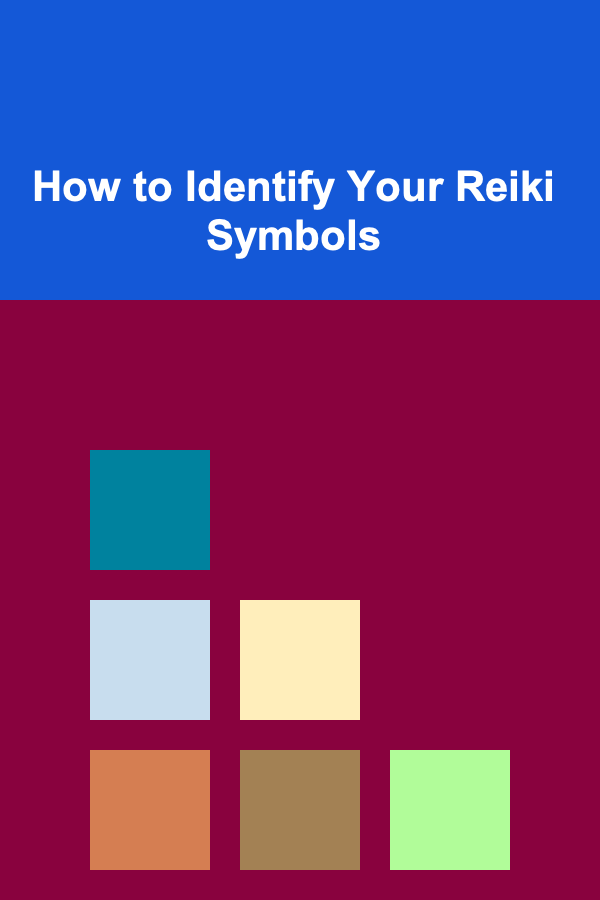
How to Identify Your Reiki Symbols
ebook include PDF & Audio bundle (Micro Guide)
$12.99$10.99
Limited Time Offer! Order within the next:

Reiki, a Japanese technique for stress reduction and relaxation, has gained widespread recognition across the world for its healing capabilities. At the heart of Reiki practice lies the use of symbols, which serve as sacred keys to accessing energy that can promote healing and balance. These symbols, often mysterious and profound, are central to a Reiki practitioner's journey. Identifying and understanding your personal Reiki symbols is not just an intellectual pursuit but an emotional and spiritual experience that can enhance your practice.
In this article, we will explore how to identify your Reiki symbols, delving into the purpose of symbols in Reiki, their various types, and the deep connection they establish between the practitioner and universal life force energy (known as "Ki" in Japanese). By the end of this piece, you will have a deeper understanding of how to identify and integrate these symbols into your Reiki practice, unlocking their full potential.
The Role of Symbols in Reiki
In Reiki, symbols are powerful tools that serve multiple purposes. They are not mere representations but are imbued with energy and intention. The primary purpose of Reiki symbols is to act as "spiritual keys" that help Reiki practitioners access and direct healing energy. Each symbol represents a different facet of the healing process and serves to connect the practitioner with a higher source of universal energy.
There are several key aspects to Reiki symbols:
- Facilitating Energy Channeling: Symbols help Reiki practitioners access and channel healing energy more effectively.
- Enhancing Focus and Intent: By focusing on a symbol, practitioners can sharpen their mental and emotional focus, which amplifies the healing process.
- Guiding Spiritual Growth: Symbols are considered a way to help practitioners deepen their connection to their own spiritual path and the greater universe.
- Protecting and Strengthening Energy: Many symbols are believed to offer protection, balance, and strength to both the practitioner and the person receiving the healing.
The process of identifying and connecting with Reiki symbols, therefore, is crucial for both beginners and advanced practitioners alike. These symbols represent more than just visual tools; they embody energy, intention, and purpose, each tailored to guide healing on different levels.
The Types of Reiki Symbols
Reiki symbols can be broken down into three main categories, each corresponding to different stages or levels of Reiki practice. Understanding these different categories is the first step toward identifying your Reiki symbols.
1. First Degree (Shoden) Symbols
The first level of Reiki, Shoden, focuses primarily on physical healing and self-care. The symbols at this level are designed to assist in channeling healing energy for the body, mind, and spirit. There are generally three primary symbols at this level, each serving a specific purpose:
- Cho Ku Rei (Power Symbol): Often referred to as the "power symbol," Cho Ku Rei is the first and most commonly used symbol in Reiki. It is used to increase the flow of energy, direct power, and establish a strong connection with the healing energy of the universe. This symbol is often drawn by practitioners to amplify energy during a session.
- Sei He Ki (Emotional Healing Symbol): Sei He Ki is the symbol for emotional healing, clearing emotional blockages, and achieving mental clarity. It is especially useful for balancing the emotional body and enhancing the mental state.
- Hon Sha Ze Sho Nen (Distance Healing Symbol): This symbol is unique in that it is used for distance healing. Hon Sha Ze Sho Nen allows the practitioner to send healing energy to others, regardless of their physical location, making it a powerful tool for long-distance healing.
2. Second Degree (Okuden) Symbols
At the second level, Okuden, practitioners learn to deepen their Reiki practice, focusing on emotional, mental, and spiritual healing. This level introduces more advanced symbols that allow for greater energy manipulation and connection to spiritual realms. The symbols at this level typically include:
- Dai Ko Myo (Master Symbol): The Dai Ko Myo is the most sacred and powerful of all Reiki symbols. It is used to invoke spiritual growth, enlightenment, and healing at the deepest levels of being. This symbol is also used to activate and enhance the practitioner's ability to perform advanced Reiki techniques, such as attuning others to Reiki energy.
- Zonar: Zonar is a symbol used in advanced Reiki practices, often for accessing the higher realms of consciousness and working with past life energy. It helps to access and heal deep-rooted emotional trauma or experiences from previous lifetimes.
3. Third Degree (Shinpiden) Symbols
At the third level, Shinpiden, Reiki practitioners experience a profound connection with the universal life force energy. The third-degree symbols facilitate transformation, spiritual awakening, and personal enlightenment. This level is often referred to as the "master teacher" level, and the symbols used at this stage are more mystical and esoteric.
- Raku: Raku is the symbol of the energy grounding process. It is often used at the end of Reiki attunements to seal and ground the energy, ensuring that the energy shifts remain balanced and permanent.
- Kundalini Symbol: This symbol is used to activate and balance the root energy of the body, connecting the practitioner to higher spiritual dimensions. It is particularly useful for unblocking stagnant energy in the lower chakras and aiding the flow of energy through the entire system.
How to Identify Your Personal Reiki Symbols
Identifying your personal Reiki symbols is a deeply personal and intuitive process. As you progress through the Reiki levels and deepen your practice, you may begin to feel a connection to certain symbols more than others. This connection can be perceived through:
- Intuitive Insight: Trusting your intuition is one of the most powerful ways to identify your personal Reiki symbols. This may come in the form of an inner knowing or a sudden connection to a symbol during meditation or Reiki sessions.
- Meditation and Visualization: Many Reiki practitioners find that symbols come to them through meditation. Visualizing the symbols, or asking for guidance from their Reiki masters or spiritual guides, can often reveal which symbols resonate with you.
- Spiritual Guidance: If you have received Reiki attunements from a master, they may also offer insight into which symbols will best support your healing journey. Your Reiki master may provide guidance on which symbols to focus on, depending on your needs and the stage of your development.
- Dreams and Symbols in Nature: Sometimes, Reiki symbols may appear in your dreams or in natural elements. For example, you may notice a recurring image in nature, or a specific shape in your dream that reflects the energy of a Reiki symbol.
- Synchronicities: Synchronicities, or meaningful coincidences, may also play a role in identifying your symbols. Pay attention to recurring patterns, numbers, or images that may symbolize a Reiki symbol or energy.
Integrating Reiki Symbols into Your Practice
Once you have identified your Reiki symbols, it's important to integrate them into your practice. The process of doing so involves more than just drawing the symbols; it involves embracing the energy and intention behind each one.
1. Daily Practice and Meditation
Spend time each day meditating on your Reiki symbols. You can visualize them during meditation or draw them on a piece of paper, focusing on their meanings and the energy they represent. This practice will strengthen your connection with the symbols and enhance their healing power.
2. Using Symbols During Reiki Sessions
When giving a Reiki session to others or to yourself, incorporate the symbols to guide the flow of energy. Visualize or draw the symbols in the air, on your palms, or over specific areas of the body. The more you use the symbols during practice, the more you will deepen your understanding and connection to them.
3. Journal Your Experiences
Keep a Reiki journal where you can record your experiences with the symbols. Write about any insights, emotional shifts, or intuitive impressions you receive when working with specific symbols. Over time, this journal will serve as a valuable tool for tracking your progress and understanding the role of each symbol in your practice.
4. Combine Symbols for Advanced Healing
Once you are familiar with your symbols, experiment with combining them during advanced healing sessions. For example, using the Cho Ku Rei (Power Symbol) with the Sei He Ki (Emotional Healing Symbol) may amplify emotional healing, or combining the Dai Ko Myo with the Zonar symbol could facilitate deep spiritual transformation.
5. Work with Your Reiki Master
If you are training with a Reiki master, ask for guidance on how to better connect with your personal Reiki symbols. Your master may offer valuable advice or attune you to symbols that will help you progress to the next level of your practice.
Conclusion
Identifying and working with your Reiki symbols is an essential aspect of your journey as a Reiki practitioner. These symbols serve as keys to unlocking the healing energy within you, facilitating transformation on physical, emotional, mental, and spiritual levels. By understanding the various types of Reiki symbols and cultivating a deeper connection with them, you can elevate your practice and experience greater healing and spiritual growth. Trust in the process, listen to your intuition, and embrace the sacred power of the symbols that call to you, for they are the guiding lights on your Reiki path.
Reading More From Our Other Websites
- [Tie-Dyeing Tip 101] Eco-Friendly Tie-Dye: Using Natural Dyes in Kids' Craft Sessions
- [Biking 101] The Ultimate Guide to Choosing the Best Fat Bike for Your Terrain
- [Home Budget Decorating 101] How to Incorporate Plants into Your Home Decor Without Spending Much
- [Home Cleaning 101] How to Clean Your Home's Air Vents and Ducts
- [Screen Printing Tip 101] Comparing Rubber vs. Polyurethane Squeegees: Which Is Right for Your Ink?
- [Tie-Dyeing Tip 101] From Dyes to Binders: Understanding the Best Tie-Dye Supplies for Long-Lasting Results
- [Home Maintenance 101] How to Keep Your Home's Concrete Surfaces Free from Cracks
- [Home Party Planning 101] How to Handle Party Cleanup Efficiently
- [Scrapbooking Tip 101] Essential Cutting Tools: Scissors, Rotary Trimmers, and Die-Cut Machines Explained
- [Home Budget Decorating 101] How to Incorporate Mid-Century Modern Decor for Less

How to Incorporate Fun Cooking Projects with Your Family
Read More
How to Organize Your Home Office for Better Productivity and Storage
Read More
How to Protect Your Home During the Holiday Season
Read More
How to Recover from Overtraining
Read More
How to Plan a Weight Loss Plan for Postpartum Recovery
Read More
How to Build a Raspberry Pi Powered Robot
Read MoreOther Products

How to Incorporate Fun Cooking Projects with Your Family
Read More
How to Organize Your Home Office for Better Productivity and Storage
Read More
How to Protect Your Home During the Holiday Season
Read More
How to Recover from Overtraining
Read More
How to Plan a Weight Loss Plan for Postpartum Recovery
Read More